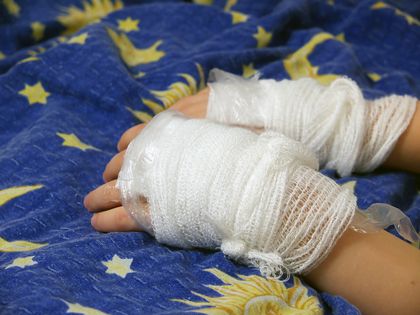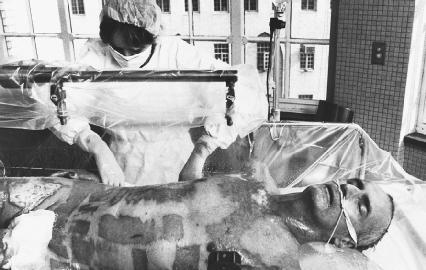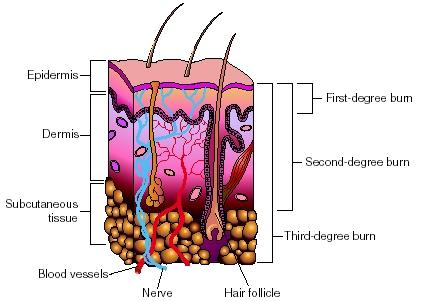Burns and Scalds - Treatment

The form of treatment used for a burn depends on how serious it is. Minor burns can usually be treated at home or in a doctor's office. A minor burn is defined as a first or second degree burn that covers less than 15 percent of an adult's body or 10 percent of a child's body.
Moderate burns should be treated in a hospital. Moderate burns are first or second degree burns that cover more of a patient's body or a third degree burn that covers less than 10 percent of BSA.
The most severe burns should be treated in special burn-treatment facilities. These burns are third degree burns that cover more than 10 percent of BSA. Specialized equipment and methods are used to treat these burns.
Thermal Burn Treatment
Thermal burns are burns caused by heat, hot liquids, steam, fire, or other hot objects. The first objective in treating thermal burns is to cool the burned

area. Cool water, but not very cold water or ice, should be used for the cooling process. Minor burns can also be cleaned with soap and water. Blisters should not be broken. If the skin is broken, the burned area should be covered with an antibacterial ointment and covered with a bandage to prevent infection. Aspirin, acetaminophen (pronounced uh-see-tuh-MIN-uh-fuhn, trade name Tylenol), or ibuprofen (pronounced i-byoo-PRO-fuhn, trade names Advil, Motrin) can be used to ease pain and relieve inflammation. However, children should not take aspirin due to the risk of contracting Reye's syndrome (see Reye's syndrome entry). If signs of infection appear, the patient should see a doctor.
More serious burns may require another approach. A burn may be so severe that it causes life-threatening symptoms. The patient may stop breathing or go into shock. In such cases, the first goal of treatment is to save the patient's life, not treat the burns. The patient may require mouth-to-mouth resuscitation or artificial respiration.

Specialized treatment for severe burn cases may also include:
- Installation of a breathing tube if the patient's airways or lungs have been damaged
- Administration of fluids through an intravenous tube
- Immunization with tetanus vaccine to prevent infection
- Covering the burned area with antibiotic ointments and bandages
- Debridement, or removal of dead tissue
- Removal of scars as healing occurs in order to improve blood flow
- Physical and occupational therapy to keep burn areas flexible and prevent scarring
Sometimes skin tissue is damaged so badly that it cannot heal properly. In that case, a skin graft may be required. In a skin graft, a doctor removes a section of healthy skin from an area of the patient's body that has not been burned. The tissue scarred by the burn is also removed. The healthy tissue is then put into place where the damaged tissue was removed. Over a period of time, the healthy tissue begins to grow and replace the damaged tissue.
Chemical Burn Treatment
The first step in treating a chemical burn is to remove the material causing the burn. If the material is a dry powder, it can be brushed off. If the material is a liquid, it can be flushed away with water. If the chemical that caused the burn is known, it may be neutralized with some other chemical. For example, if the burn is caused by an acid, a weak base can be used to neutralize the acid. The burned area can then be covered with a clean gauze and, if necessary, treated further by a doctor.
Electrical Burn Treatment
As with severe thermal burns, the first step in treating electrical burns usually involves saving the patient's life. An electrical charge large enough to burn the skin may also produce life-threatening symptoms. The source of electricity must be removed and life support treatment provided to the patient. When the patient's condition is stable, the burn can be covered with a clean gauze and medical treatment sought.
Alternative Treatment
Serious burns should always be treated by a medical doctor. Less serious burns may benefit from a variety of alternative treatments. Some herbs that can be used to treat burns include aloe, oil of St. John's wort, calendula (pronounced KUH-len-juh-luh), comfrey, and tea tree oil. Supplementing one's diet with vitamins C and E and the mineral zinc may help a wound to heal faster.

Comment about this article, ask questions, or add new information about this topic: